Mushrooms in Michigan are plentiful and varied, providing a wealth of culinary opportunities for anyone willing to explore the many species that grow in the state.
From morel mushrooms, which are prized for their savory flavor, to oyster mushrooms, whose delicate texture makes them ideal for soups and stews, Michigan has something for everyone.
Below we’ll discuss common fungi in MI, how to identify and more.
List of Edible Mushrooms in Michigan
1. Oyster Mushrooms
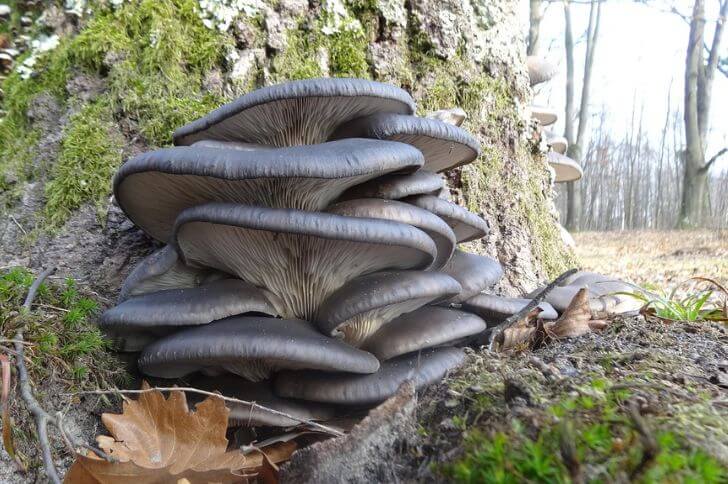
There are various oyster mushrooms in Michigan. Common varieties include:
- Pearl Oyster mushrooms (Pleurotus ostreatus)
Pleurotus ostreatus is a delicious and nutritious mushroom that is commonly found growing on trees, logs, and stumps. Commonly called pearl oyster, this mushroom can be identified by its distinct oyster-shaped cap that can reach up to 11.75 in diameter with a smooth texture. The color of the cap ranges from white to gray depending on its maturity.
Pearl oyster gills are white and run down the stem. They are gray in young species, turning yellowish as the oyster matures. The stem of this edible MI mushroom is usually short, thick, and off-center with a tough texture.
In the wild, these oysters can be found on living or dead beech. You can also cultivate them at home.
- Golden Oysters (Pleurotus citrinopileatus)
Pleurotus citrinopileatus, commonly called golden oyster Mushroom, is loved for its distinct flavor and texture.
The cap can range from yellow to golden-brown in color and has a smooth surface that is convex when young and becomes flat or depressed with age. On the underside, golden oysters are white with gills running down the stem. Speaking of stems, they typically are short and stubby, sometimes curved or twisted.
Like other oysters, these mushrooms have white unchanging thin flesh. You can find golden oysters in clusters growing on dying elms in summer and fall.
- Pink Oyster Mushrooms (Pleurotus djamor)
Another variety of oysters in Michigan are pink oysters. Unlike its cousins, these are grown in farms. And with a good grow kit, you can grow them in your shed.
This fungus has a pink to salmon-colored cap that grows in clusters. The gills of the mushroom are widely spaced and run down the length of its stalk.
Oyster mushrooms can be pan fried, used to make delicious mushroom tacos, in salads and more.
2. Morels
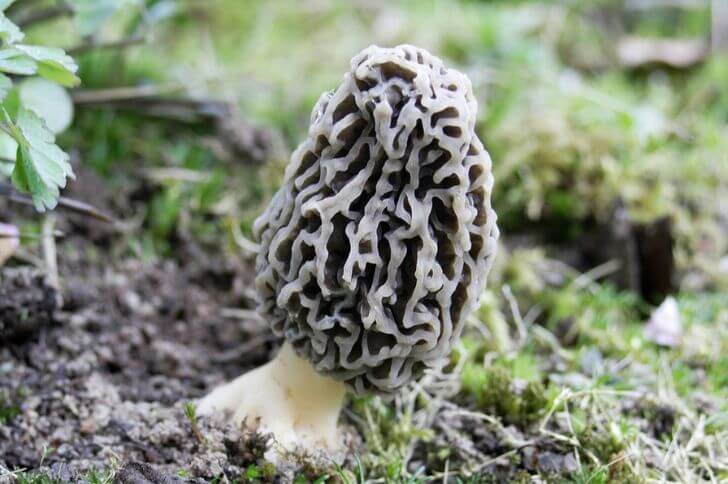
From late April you may notice a lot of excitement across foraging groups on different social platforms; its morel season.
Morels in Michigan start popping out from late April lasting through the end of June depending on the location. Common morels in the Great Lake State include:
- White morels
White morels have a distinctive conical shape with wrinkled or pitted ridges on the cap that give it a honeycomb-like appearance.
The color of these Michigan morels can vary greatly depending on age and location, but they typically range from creamy white to light tan in color.
The stem is hollow and usually white, although it may be slightly yellowish. When hunting for white morels in the wild, look for them growing near hardwood trees such as ash and elms.
- Half-free Morels
One way to identify half-free morels is to look at the shape of the cap. The cap should be cone-shaped with an elongated stem. The cap should also have ridges or pits that look like honeycomb patterns. Another characteristic to look for is the color of the cap which can range from tan to brown.
Another way to identify half-free morels is by examining their habitat. They tend to grow in beech-maple forests. Note, they reappear around the same area but not yearly. They may pop up one year and disappear for the next two.
- Burn-site morels
These elusive fungi can be found growing in areas that have been recently burned by fires, making them a rare find for mushroom hunters.
Like other MI morels they have honeycomb caps that are dark brown in color. The cap is attached to the stem at the base, and the stem itself is hollow and white. They mostly appear after a forest fire.
- Black morels
One of the key features to look for when identifying black morels is their shape. They typically have a cone-shaped cap that is wider at the base and narrower at the top. The cap is pitted, which is another distinguishing characteristic.
Another important factor to consider when identifying black morels is their color. As the name suggests, these mushrooms are typically dark in color – ranging from dark brown to almost black – with a honeycomb-like texture on their surface.
NB: If you want to learn more about morels, we recommend you attend the National Morel Mushroom Festival held yearly in Boyne City.
3. Chanterelles
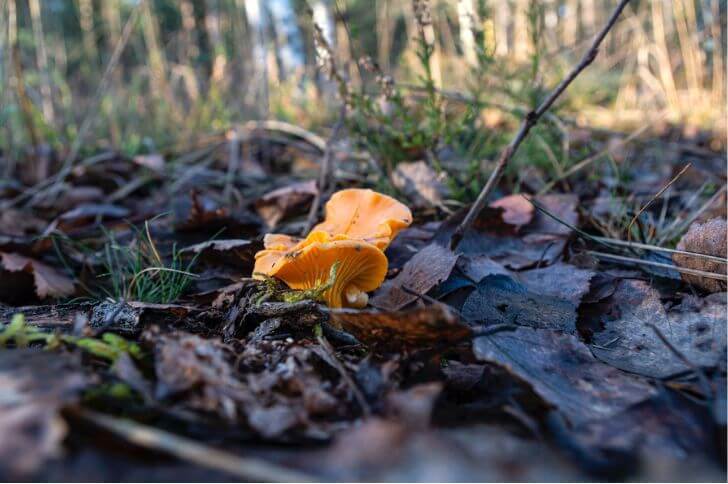
Chanterelles in Michigan fruit from June to September. Here are some varieties you may find in the wild.
- Golden chanterelles
The golden chanterelle is characterized by its vibrant yellow-orange color, funnel-shaped cap with distinctive ridges on the underside, and thick stem.
- Ghost Chanterelle (Cantharellus phasmatis)
Cantharellus phasmatis is a type of fungus known for its unique and elusive nature. Its name, which translates to “ghost chanterelle,” reflects the difficulty in locating and identifying this species.
It can be identified by its trumpet-like shape, yellow-orange coloration, and distinctive ridges on the underside of the cap. However, these features are not always easy to distinguish from similar species like golden chanterelles.
- Cantharellus roseocanus
Cantharellus roseocanus are egg-yolk yellow becoming pale yellow as they age. Under the cap you’ll note false gills running down the stem. They have a fragrant odor that allows you to smell them before you see them.
4. Flammulina Velutipes
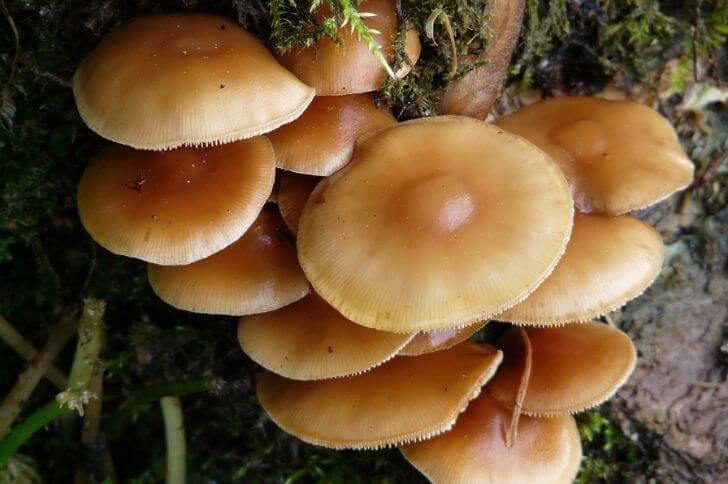
Flammulina velutipes is a brown edible mushroom commonly known as velvet shank in Europe. In Michigan, it appears in spring and fall. The mushroom typically grows in tight bunches.
Each mushroom has a convex to flat cap that grows to around 3 inches. Pale yellow gills characterize its underside while the long, curved stem grows to about 4.3 inches.
Velvet shanks are very tasty. You’ll love its sweet, mealy flavor.
5. Plums and Custard (Tricholomopsis rutilans)
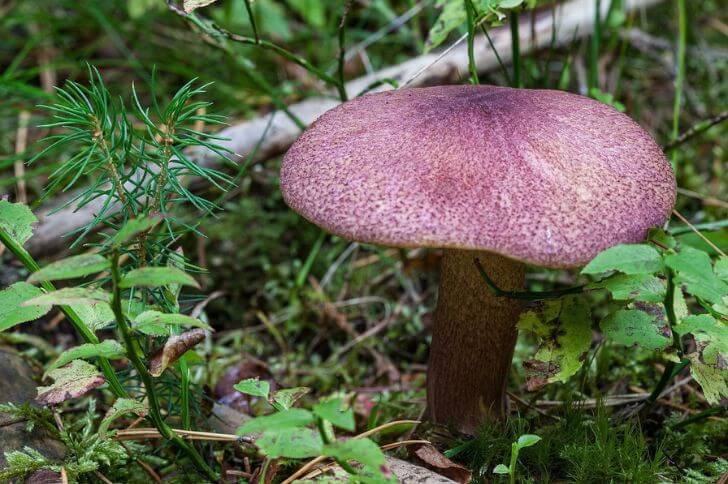
Plums and custard mushrooms are edible, however most people avoid them. Also called red-haired agaric, tricholomopsis rutilans are strikingly beautiful species that favor coniferous forests.
The color of the cap varies from reddish-purple to brick-red. It’s initially bell-shaped, becoming flatter with age. On the underside, check for yellow crowded gills to identify this species. Lastly, you can identify plums and custard by its rotten pinewood smell.
Though classified as edible, foragers avoid this red mushroom in Michigan due to its rotting wood smell and taste.
Also read: Wisconsin Mushrooms
6. Wood Blewit (Clitocybe Nuda)
Wood blewits are a great find. Loved for their meaty texture, they start out lilac turning brown as they age.
This mushroom grows in organic debris in scattered groups. A mature mushroom can measure about 4.7 inches across. The fruiting body is bluish-purple. Also their sweet fragrant odor can help you tell them apart from field blewits. Note, wood blewits are edible. Ensure to cook well and start with a small portion.
7. Deer Mushrooms (Pluteus cervinus)
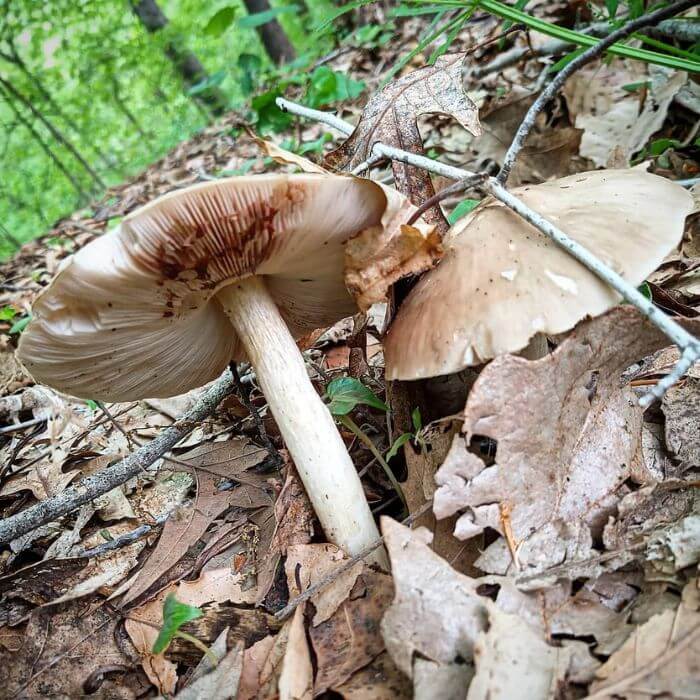
source: karatebartender
The deer mushroom has a cap that ranges from 1.2-4.7 inches in diameter and first is convex before flattening out as it matures. The cap color varies between shades of brown to grayish-brown with a smooth surface that may be darker towards the center.
The gills are widely spaced and are initially white but turn pinkish-brown as the spores mature.
Another key characteristic is its stem which is covered in fine hairs. Deer mushrooms are edible but have no culinary value.
8. Maitake (Grifola Frondosa)
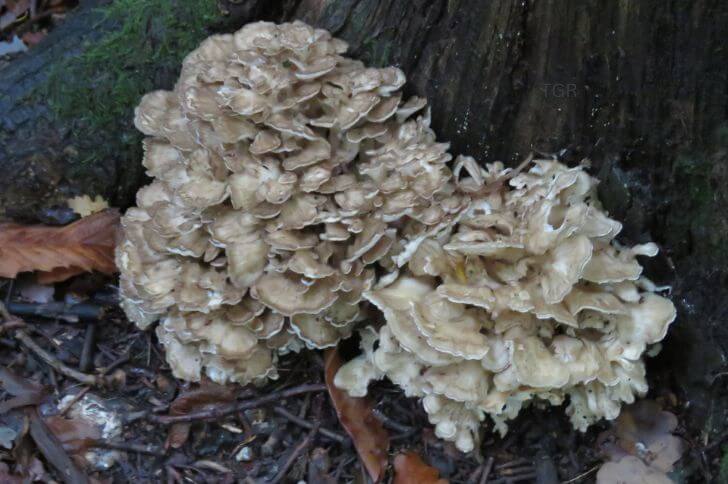
Maitake typically grows in clusters at the base of maples and oaks. Look for a large mushroom with brownish-gray fronds or petal-like caps. The caps can range from 2-10 inches wide and have a velvety texture.
Another characteristic to look out for is the underside of the cap which has tiny pores instead of gills like many other mushrooms. These pores start out white but turn yellowish-brown as the mushroom matures.
Maitakes can grow up to 40 inches and weigh up to 80 pounds, making them a great find.
9. Dryad’s Saddle (Polyporus squamosus)
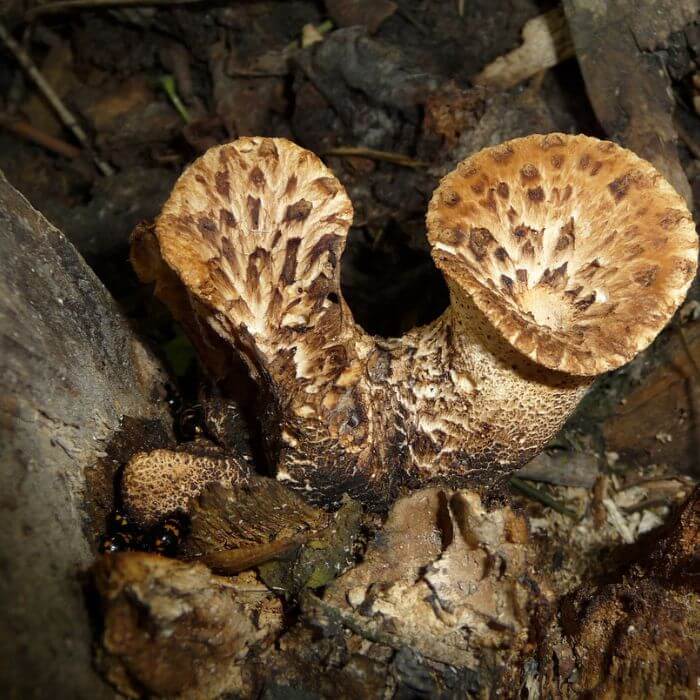
Dryad’s Saddles are another common type of Michigan Mushrooms. They grow on logs or stumps of hardwood trees. The fruiting body can range from 2-11 inches in diameter, with a distinctive shape that looks like a saddle.
The cap of the mushroom is composed of overlapping scales, which give it a scaly appearance. The color can vary between light brown to dark brown shades, depending on age and environmental conditions.
Related Read: Also check common mushrooms in Ohio
10. Hedgehog Mushrooms
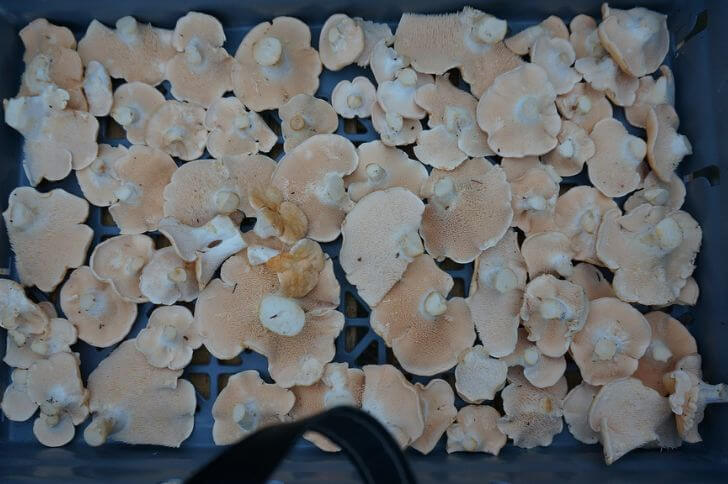
Hedgehog mushrooms get their name from the spiky, toothed underside of their caps, which resembles a hedgehog. These mushrooms have a meaty texture and a robust flavor that makes them an excellent addition to many dishes.
They typically grow on the ground near trees in late summer and early fall. The cap ranges in color from tan to dark brown. The stem is thick and short.
Hedgehog mushrooms are safe to eat as long as they are properly identified and well cooked.
11. Chicken of the Woods
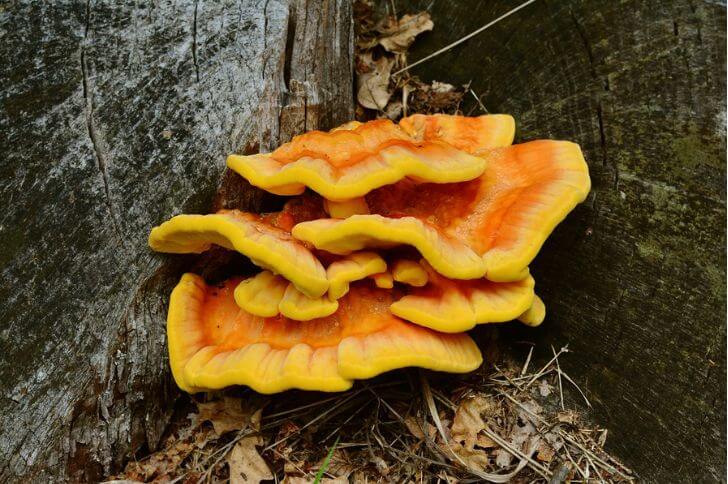
Preferring oaks, cherry and beech trees, chicken of the woods are one of the tastiest mushrooms on this list. The bright orange-yellow color and unique texture make it easy to spot once you know what to look for.
Its growth pattern typically forms large clusters with overlapping caps that range from 2-20 inches in diameter. Another important characteristic is its flavor – it has a sweet flavor similar to cooked chicken which gives it its name.
Inedible Mushrooms of Michigan
12. Witch’s Butter (Tremella mesenterica)
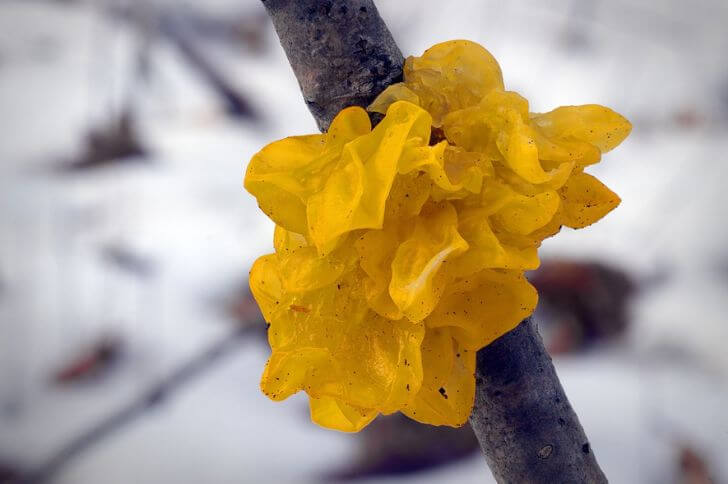
Tremella mesenterica, also called the yellow brain fungus or more commonly witch’s butter, grows on dead or decaying oaks. It has a distinctive yellow-orange color and a unique brain-like appearance, making it easy to identify once you know what to look for.
The fungus typically forms gelatinous lobes or convolutions that resemble brains or coral reefs. Its surface is smooth and shiny when wet but becomes dry and rough when it dries out.
Another factor to consider when identifying witch’s butter is its habitat. This species prefers damp environments such as forests or wooded areas where there is plenty of decaying wood for it to grow on.
13. Cinnabar-red polypore (Trametes cinnabarina)
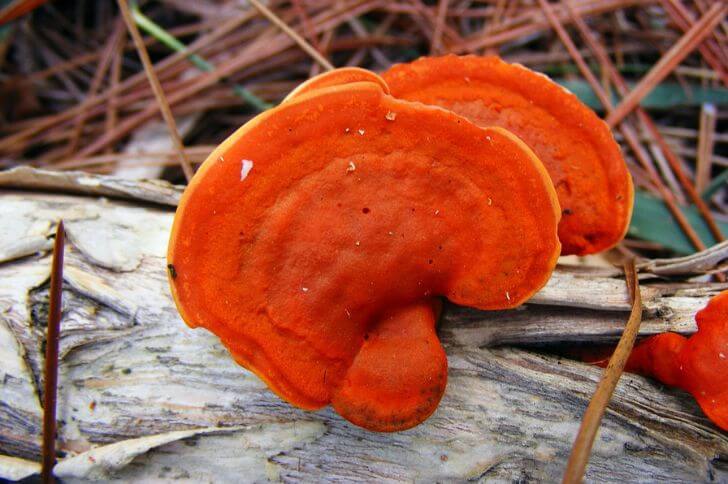
Trametes cinnabarina is commonly known as the cinnabar-red polypore. This species belongs to the basidiomycota division of fungi.
The fruiting bodies of these shelf fungi are characterized by their striking crimson-red coloration on the upper surface, while the lower surface appears paler with small pores. The cap shape varies from semicircular to kidney-shaped, with a smooth texture and a thickness of 0.4-0.8 inches. They appear in late spring through fall, and can sometimes be found in winter.
14. Velvet-toothed Polypore (Trichaptum Biforme)
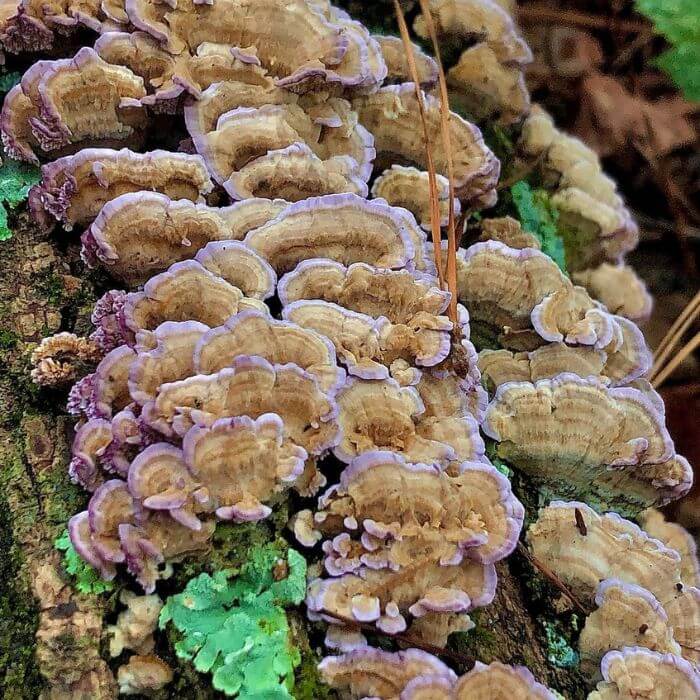
source:mycolo.core
Velvet-toothed polypore is closely related to turkey tails. However, they are not as gorgeous as their cousins.
This shelf fungus has a purple-brown upper surface with a smooth texture and purplish pores underneath. Its cap ranges from 0.2-3 inches in diameter and it typically grows up to 3mm thick.
These purple mushrooms in Michigan are inedible.
15. Scurfy Twiglet (Tubaria furfuracea)
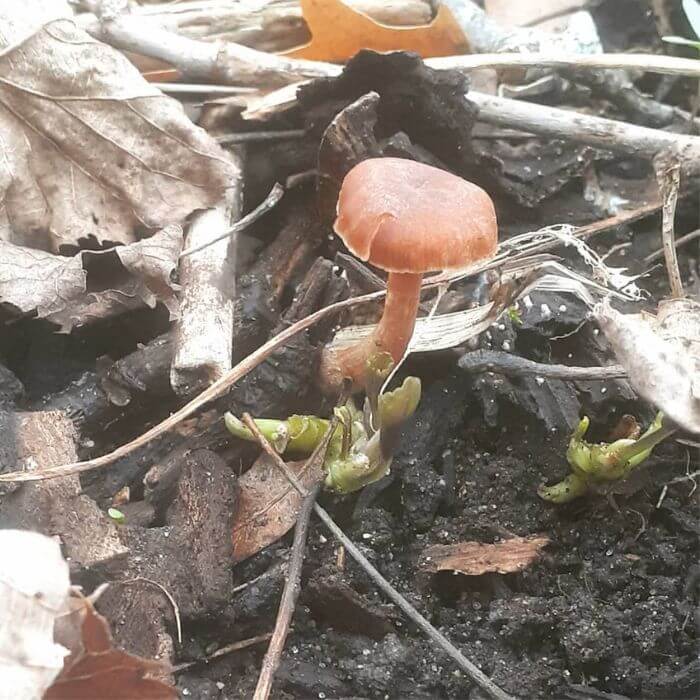
source: cocostos_shroomwhisperer
Tubaria furfuracea or the scurfy twiglet is a common brown mushroom in Michigan. This mushroom has a distinct appearance that makes it easily identifiable to seasoned mushroom hunters and enthusiasts alike. The cap is typically brown with a darker center. It starts out convex, eventually becoming flat with maturity.
The gills on the underside are fairly spaced. Another distinguishing feature is its stem which has a scaly appearance due to small patches of fibers covering its surface. These fibers can be removed by gently scraping them off with your fingernail, revealing a smooth brown stem underneath.
Scurfy twiglets are inedible.
16. Jack O’Lantern (Omphalotus illudens)
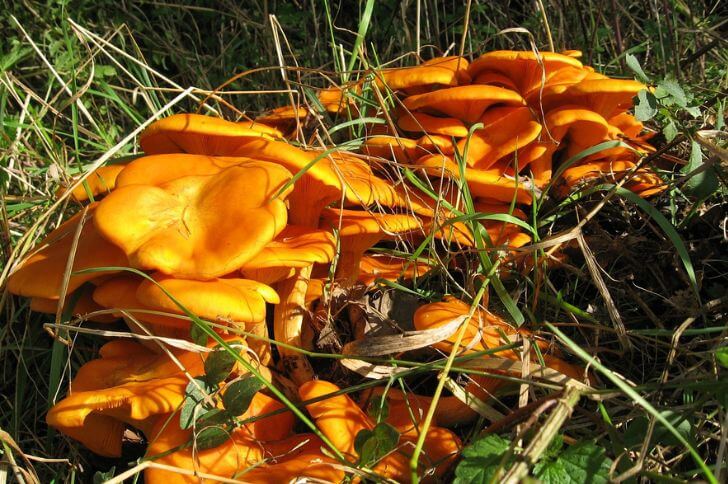
Where chanterelles dominate, jack o’lanterns are bound to show up. It’s important to tell these two Michigan Mushrooms apart.
This species gets its name due to its bright orange color and bioluminescence feature. Another way to tell it apart from chanterelles is by looking at the underside of the bright yellow orange cap. Jack o’lanterns have crowded true gills. Like chanterelles’ they run down the long stipe. Jack o’lanterns are inedible.
FAQs
What is the most common mushroom in Michigan?
Honey mushrooms. These can be identified by their caps which range from yellowish-brown to reddish-brown color. They grow in clusters on tree stumps. The fruiting body of this fungus can range in size from small to large depending on environmental conditions.
What is the most expensive mushroom in Michigan?
Michigan truffles. The fruiting body of this truffle is round or oval-shaped with deep channels running along its surface. These channels are formed by ridges that extend from the base of the fungus to its apex. The color of the truffle can vary from light brown to almost black depending on the maturity stage.
A pound can cost up to $800.
Where is the mushroom capital of Michigan?
Mesick. This unassuming town may not look like much at first glance, but take a closer look and you’ll soon discover why it’s considered Michigan’s mushroom capital. Mesick boasts some of the best soil conditions and weather patterns for growing mushrooms, making it an ideal location for farmers to cultivate their crops.
source:
Hi There,
My name is Jenny. I’m the Chief Editor at Try Green Recipes and besides making yummy and healthy foods for my kids, grandkids, and friends. I’m new to the blogging world but I believe what I have to share is unique and will bring joy to your home. If you are adventurous and want try something tasty, let’s get started.

